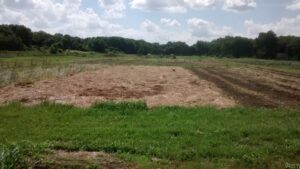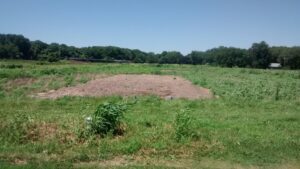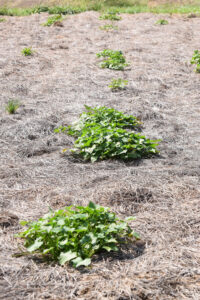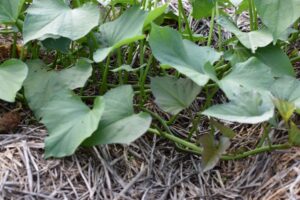Final report for FNC16-1029
Project Information
Buller Family Farm grows a diverse mix of around 40 difference crops of vegetables and berries. We have been growing commercially for 11 years, and produce certified organic crops for a local CSA subscription service and the farmers market. As an organic grower we have been focused on building soil health and rotating cover crops, but have been working to minimize tillage in our production systems and increase organic matter in our soils.
This project was conceived as a way to explore ideas that are commonly called no-till organic production and attempt to test how well those ideas would integrate into sweet potato production. In order to trial minimal tillage on my farm, I decided to compare 2 different systems of "no-till" organic agriculture with my standard tillage based production system. One of these systems consists of a deep straw bed that is planted into, and the deep mulch provides ample cover to smother any weeds that could germinate. The second system is often referred to under the moniker no-till but is really more intermittent tillage, in that the field is tilled in the preceding season to plant a cover crop, which is then rolled prior to planting and ideally that residue will prevent weed competition for the crops. This project tested these ideas in trial plots in 2016 and 2017 and presented the information to other farmers in a field day, as well as numerous workshop and conference presentations to share what was learned. The basic conclusion from our trials is that neither of these two no-till options are feasible for our farm to use to produce sweet potatoes. Much can be learned in failure and the research report highlights several challenges that could be helpful for anyone considering working with either of these two systems. These include mulch sourcing, cover crop termination, weed control and wildlife management.
At the end of the two years, this project succeeded in the following objectives:
- Determine that organic no-till production systems for sweet potatoes are challenging to manage and until the challenges can be overcome not economically viable for Northeast Kansas.
- Highlight specific challenges of implementing no-till production practices for further research and refinement
- Provide this information to over 70 growers and agriculture professionals
Research
The research part of my project was based upon a simple experimental design. I established a quarter acre trial plot split into three equal sections. To equalize the pre-treatments of all sections, each had an identical mix of cover crops established in the fall preceding the trials. In season one the mixture was cereal rye and Austrian winter peas. In season two the mix was cereal rye and vetch.
In one section I left the cover crop until it was terminated (theoretically) by rolling with the roller on the back of my flail mower. In the second section, the plan was to spread seven round bales of straw, and the third section I used as the control and tilled and managed in my conventional manner (with a 6’ rototiller behind the tractor). As this was exploratory rather than a detailed scientific experiment there were no replications.
In year one, at the end of May I rolled the cover crop using the roller on the rear of my flail mower. Into each of these sections we planted six rows of sweet potatoes of two cultivars- four rows of Beauregard and two rows of Bonita. The slips were sourced from K-State Research and Extension. The rows were cultivated as needed and able. In the control, this consisted of two passes with tractor cultivation in the control plot, until the vines had run too much, and a final pass by hand, mostly to control pigweed. The rolled cover crop plot and straw mulch plot were weeded by hand, although the straw plot required essentially no weeding throughout the season (5 minutes total), due to the density of the mulch. The weeding time of the rolled cover crop plot ended up being almost double that of the control as hand weeding became the only option. After a light frost in October the sweet potatoes were harvested by hand and weighed. At harvest the crops were sorted for damage from mice/voles and other causes and assessed for percentage of marketable sweet potatoes.
In year two, the goal was to replicate this experiment, using some lessons learned and the no till planting aid which had been developed over the winter and spring of 2017 to make some of the planting more efficient. However two significant challenges occurred that resulting in the sweet potato slips never even being planted. First, in season two I experimented with a different mix of cover crops, rye and hairy vetch instead of rye and Austrian Winter peas. I had read in various places that the roller on the back of a flail mower could work almost as well as a roller crimper for terminating cover crops, and my experience with rye and winter peas in 2016 bore that out. However the hairy vetch would not die by simple rolling. The rye was beginning to set seed and the hairy vetch was flowering, which from my reading was the time to roll them down. The dense mass rolled down nicely and appeared to have been terminated along with the rye when I rolled it in late May 2017. Then several days later I noticed the vetch popping back up. I rolled the field again. Again it popped back up. I realized I couldn't terminate the vetch cover and if I planted into it, I would lose the planting and the vetch would go to seed and leave me a problem for the future. Indeed even with the extra time I left the vetch after flower in attempting to roll it multiple times allowed some of it to go to seed and in fall 2017 there were vetch seedlings germinating in this plot. I decided not to plant that plot and compare the straw bed system to the control. Good straw seems hard to find, and I found some that had been designated by the grower as not treated with herbicides. I ordered it and was expecting delivery after the 2017 wheat harvest, sometime in mid-late June. This is a bit on the later end for planting sweet potatoes, but I couldn't find any straw that would have been available earlier. As the delivery time approached, I waited and waited. Apparently the farmer who was delivering got busy and did not deliver until over a month late. The sweet potato slips I had ordered had rotted in holding and it would have been too late to plant them even if they had somehow survived. This highlights one problem for the deep straw mulching system- access to adequate amounts of straw that have not been treated by herbicides. This system might work well for a wheat farmer or someone who could guarantee access to straw, but it seems to be a critical failure point if reliant upon other farmers.
Impacts
Results and Lessons Learned
 2016 Field View of Straw mulch plot (center), tilled plot (right), rolled cover (left)
2016 Field View of Straw mulch plot (center), tilled plot (right), rolled cover (left)
 Mid-summer overview
Mid-summer overview
 Straw-mulched sweet potatoes
Straw-mulched sweet potatoes
 Mulched sweet potatoes
Mulched sweet potatoes
The yield results are as follows expressed as Pounds harvested per cultivar:
| Good (lbs) | Bad (lbs) | Percentage Marketable | ||
| Section 1 -Control | ||||
| Beauregard | 266.40 | 101.9 | 72 | |
| Bonita | 124.92 | 32.78 | 79 | |
| Section 2- Straw Mulch | ||||
| Beauregard | 18.74 | 1.66 | 92 | |
| Bonita | 2.94 | 0.54 | 84 | |
| Section 3- Rolled Cover | ||||
| Beauregard | 79.76 | 19.32 | 81 | |
| Bonita | 22 | 0.8 | 97 |
The results are pretty grim for both of the no-till trials. I have heard from no-till advocates in the row crop arena that there is a five year window where yields are depleted as the soil rebuilds the biota needed to make no-till successful. These trials are far below those levels and indicate that we had not mastered the methods of no-till on farm.
This project tested my commitment to soil health building through no-till practices. The conventional tillage plot was so much easier to plant, maintain and had a much greater yield. Part of that is certainly due to the fact that I am experienced and equipped for the conventional tillage system, but it is hard to overlook the massive discrepancies in yield.
The surprising result is the higher proportions of marketable crops in the no-till systems. My initial hypothesis was that the mulch would offer idea situation for pests, moles, voles and mice, so that they would have a higher bad percentage than the control.
Here are my current thoughts on the two no-till systems I experimented with. I feel like the rolled cover crop was the best compromise, but it provided challenges that certainly need to be addressed. In 2016, I felt that I had established a good cover over 90% of the trial space with a solid stand of rye between 5-6 feet tall interspersed with peas. I realized I was wrong a while after rolling the crop and planting the sweet potatoes, when weeds became rank in that field. At this point, the rolled-cover “no-till” option becomes a hindrance to the ability to use mechanical weeding. There is enough mulch and debris to hinder tractor cultivation or even hand hoeing, but not enough to effectively suppress weed growth. We tried to do our best weeding by hand, but some weeds, especially Johnsongrass (Sorghum Halepense) became established in this section. This will provide an ongoing challenge to using this space in the future. The lack of ability to easily control weeds seems to be a critical challenge for rolled cover crop based systems. Based upon conversations with Dr. Ron Morse in early 2017 I realized the secret to solving this is before implementing this system make sure that the area is free of perennial weeds. We have some slight problems with Johnsongrass in our normal system, but without the control of mechanical tillage it was allowed to spread. In 2017, the challenge was that I simply did not understand the cover crop I was growing well enough. Hairy vetch will not die without being crimped which unfortunately I found out the hard way.
I also learned a lot about straw mulching. Besides the access problem that doomed the 2017 trial, in 2016 we had difficulty establishing sweet potatoes in the straw mulch. There were a few reasons for this. The mulch surface can become very hot under the summer sun and that tended to desiccate and kill tender slips before they had a time to root. I needed to provide more space between the slips and the straw to prevent that heat concentration. Additionally, this year my farm faced more deer pressure than it had in the past, and the straw mulch provided a unique opportunity for the deer. The straw mulched area was particularly weed free, so the deer were able to focus on eating the tender and tasty sweet potato leaves, and frequently grazed this area. This limited plant growth significantly. Finally, straw being a good insulator, the sweet potatoes plants there died much earlier than the non-mulched area. The leaves seemed to be insulated from the warming effects of the soil, so a very light frost, which normally provides a bit of leaf burn to the other plants terminated the sweet potatoes on the straw section. While this was too late in the season to limit growth it was an interesting observation that could be important in regions where sweet potatoes are challenged by late season frosts.
In addition to the production method specific insights, I learned a number of other lessons through this project. First and foremost, I realized my project plan had a few flaws in design, in that a few challenges changed some of the proposed procedure. At critical points in the season I was short staffed, due to the departure of a long-time employee. As a result, I failed to conduct the initial soil test in a timely fashion, so the soil testing component -- that would have been added in year 2 -- was scrapped entirely once I realized that planting it would not be possible. Additionally, I did not budget adequately for the no-till planting aid, so I did not build one this year. I have been trying to source used parts to make it economically feasible for year two. The result of this was that planting in the no-till plots in year one was more labor intensive than it probably should have been.
The no-till planting aid proved to be a challenge to create. In 2016 I ran out of time before planting as I fiddled around with it, so we ended up planting by hand. In the process I discovered I had under budgeted, hoping to build it with some scrap parts, so I re-budgeted in early 2017 After much experimentation in 2017, I came up with a no-till planting aid I hoped would work that relied upon some fertilizer injection knives with rolling colters in front to cut through the residue. I have seen similar designs work in rolled cover crops, but I was very curious if it would function in a deep straw mulch. Due to the challenges of accessing the straw in a timely fashion, I never trialed the no-till planting aid in that system, so that would be one area for future experimentation.
Educational & Outreach Activities
Participation Summary:
After learning many unexpected lessons from this project, I spent a considerable effort on outreach in order to share with other growers in the area.
Information about this project was presented at the following venues.
Growing Growers is a KC metro organization that provides training for new fruit and vegetable growers. This information was presented at a Growing Growers workshop on Conservation Agriculture in September 2017 in Lawrence, KS. This included a PowerPoint demonstration of the project and a field visit to the farm. There were 18 attendees. This was publicized by the Growing Growers Organization on a listserve for the KC Metro area, a website and facebook. Here is a flier.2017-GG-Conservation-Ag
In October, a summary of this project was presented on PowerPoint to 12 people at a Lincoln University Workshop on the SARE Farmer Rancher Grant in Independence MO. Agenda
Information on this project was presented via PowerPoint and discussion in two sessions at the Kansas Rural Center 2017 Farm and Food Conference in November in Manhattan, KS. The first session was about conservation practices and had 30 attendees and featured an in-depth discussion of cover crops, mulching and no till options and challenges for organic growers based upon the conclusions drawn from this research. The second session was about the SARE Farmer Rancher Grant and included a basic summary of the project and conclusions and also reflections on conducting on-farm research. AGENDA-2
Additionally this research was incorporated into a talk to be presented at the Great Plains Growers Conference in January 2018, but the Soil Health track was canceled due to inclement weather.
Learning Outcomes
The main lesson that I learned is that no-till is complicated in a way that tillage based systems are not. There are many variables that need to be accounted for outside of normal planning. For instance the surface temperature of the straw. I tried to take the no-till systems I had read about and apply the techniques to a crop I thought would work (sweet potatoes). I made several critical errors throughout the trials that seemed to ensure that the no-till trials had yields that were not sustainable from a market level. Because of this failure, I have redoubled my efforts to implement crop rotations that maximize the use of cover crops in times when cash crops are not present as the primary way of building soil organic matter. I have decided to limit further no-till crop experimentation to things that have proven successful in this region, mostly pumpkins and winter squash. I have also decided that no till systems are not something I am ready to do more with than just experiment.
If asked for a recommendation, I would advise other growers to go slowly into using these practices and consult those who have experience rather than simply reading reports of how to do this. After 1 year of the project I had the opportunity to see Dr. Ron Morse, who is a professor emeritus from Virginia Tech and a organic no-till pioneer in the horticulture world. I was able to discuss with him some of the challenges I had discovered in year one. He advised spending several years prior to implementing a no-till strategy making sure that perennial weeds like Johnsongrass are well controlled before beginning no till planting. That would certainly have helped the problems I experienced in my rolled cover crop trial plot. We have Johnsongrass around our farm, but we can control it in our regular system via tillage. Without that control, it can spread and become pervasive, so if I were to try this again on a scale, I would spend a good deal of time before beginning to bring that under full control.
Project Outcomes
I appreciated the opportunity to conduct this research and education project.
I think further study and experimentation is merited, because at one of the outreach events I spoke with one grower who has been able to successfully employ the deep mulch no-till method on his farm.